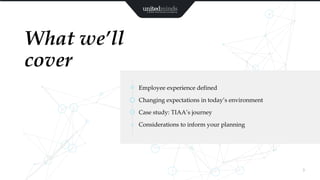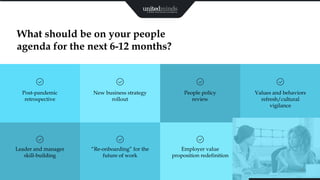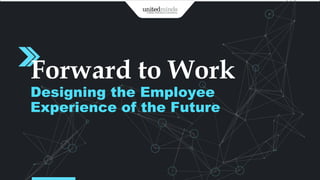United Minds’ Forward to Work: Designing the Employee Experience of the Future
- 1. Forward to Work Designing the Employee Experience of the Future
- 2. 2 With us today Andy Habenicht Chief Employee Relations and Associate Experience Officer Josh Greenwald SVP and Chief Talent Management Officer
- 3. 3 Employee experience defined Changing expectations in today’s environment Case study: TIAA’s journey Considerations to inform your planning What we’ll cover
- 4. Employee experience defined 4 Employee experience (EX) is an emerging business discipline focused on positively influencing how employees think and feel during every touchpoint of their journey with an employer. • Emerged as a direct outgrowth of and is a corollary to Customer Experience (CX) • Requires organizations to work outside the scope of the typical HR function • Delivers a proven impact on performance Utility What do employees need to work? Productivity What do employees need to work better and faster? Engagement How can we make employees happy so they perform better? Experience What does the work experience need to look like so people want to show up vs. have to show up? Source: Jacob Morgan
- 5. 5 Physical Technological Social Operational Cultural The employee experience has arguably changed more in the last 10 weeks than it has in the last 10 years Changes in the business landscape and companies’ response strategies have impacted every aspect of the employee experience FIVE DIMENSIONS OF THE EMPLOYEE EXPERIENCE
- 6. 6 Many companies have risen to the challenge and are preparing to play the long game Solving for employees’ short-term needs while rethinking their longer term employee value proposition RESPOND - Temporary closures - Modified schedules - Home office stipends - Paid sick leave - Mental health programming - Voluntary separation programs RESET - Doubling down on employee listening - Engaging medical and facilities consultants - Experimenting with work schedules and locations - “Re-onboarding” employees REINVENT - Understanding changing expectations - Addressing needs and pain points in the associate experience - Strengthening culture to accelerate new business strategies - Building a responsive and differentiated employer brand
- 7. In a period where traditional rules no longer apply and norms are being negotiated daily, now is the time to define what the new world looks like and employees’ role within it. Those who do will come back stronger than ever.
- 8. 8 The six tension points every employer will have to navigate in the next six months On-site Expansive Leadership-driven Digital-centric Short-term actions Investing in self Remote Limited Employee-driven Human-centric Long-term reform Investing in others 1. WORKPLACE 2. ROLE OF THE EMPLOYER 3. SOURCES OF INFLUENCE 4. ORIENTATION 5. DIVERSITY & INCLUSION 6. RESOURCE ALLOCATION
- 9. Times of crisis require employers to be culturally vigilant 9 It’s not whether COVID, the fight for racial justice and other macro forces will influence company culture but how. Organizations can’t just let culture happen but must continually define, design and nurture it. . CODIFYING POSITIVE CULTURAL SHIFTS UN-LEARNING CONCERNING CULTURAL SHIFTS • More transparent • More agile • More humble • More empathetic • More judgmental • More competitive • Less work/life balance • Challenges to collaboration and inclusivity MONITORING FOR THE 6 KEY CULTURAL RISK FACTORS
- 10. A Case Study: TIAA’s Journey
- 11. 11 About TIAA • Founded by Andrew Carnegie in 1918 to help teachers retire with dignity • Today, many in the not-for-profit industry rely on TIAA for a wide range of financial products and services • Approximately 17,000 employees globally • Guided by our values to put the customer first, value our people, act with integrity, deliver excellence, take personal accountability and operate as one team • Current employee value proposition is “Be a Difference Maker” with a focus on the company’s mission and spirit of serving those that serve
- 12. TIAA’s journey to become more employee-centric ACTIVITY: PRIDE IN WORKING AT TIAA: 2007 2008 2009 2010 2011 2012 2013 2014 2015 2016 2017 2018 2019 2020 Jan 2020: TIAA reintroduces its mission and new strategy Mar 2020: TIAA asks workforce majority to work from home, creates intensive COVID associate response, launches Virtual Workplace Experience & Listening Strategy Apr 2020: TIAA COVID Survey Jun 2020: TIAA Pulse Survey on Engagement, Productivity & Wellbeing Fall 2020: TIAA rolling launch of reinvigorated employee value proposition 2019: TIAA scales back TWS, introduces “Dress for my Day”, and Responsible Time Off Listening Sessions, Culture Steering Committee, and Employee Experience Function Established People Deal strategy conceived 2018: Centennial – EVP was introduced 2017: TIAA acquires EverBank 2007: TIAA introduces remote working policy 2010: TIAA establishes 10 year strategic plan 2014: TIAA acquires Nuveen 2016: TIAA re-brands 2014: TIAA establishes its 6 Core Values
- 13. 13 Power of Mission, Purpose, and Strategy to People Engagement Vital to talk about experience and culture attributes to answer the “why” from associates Employee-centricity and listening has no substitute Using our Values to guide our decisions Leadership and care through crisis can build rapid trust and credibility equity with people—but how do you sustain? What we’ve learned
- 14. 14 Where we’re Using the voice of the employee to define and deliver our experience and culture “people pledge” Maximizing our virtual experience and effectiveness with our core Value (“Value our People”) Articulating the behaviors we ask of our people to capitalize on news ways of working in a dynamic environment focused Thoughtfully defining and implement a dynamic work model and ensuring our experience supports it Critically evaluating our “office culture”—what will it mean, how will it change Doubling down on adoption of stronger change management practices and “Agile” work methodology
- 15. Client retention & attraction ASSOCIATE-TO- CLIENT VALUE CYCLE Growth Associate experience Associate engagement Client satisfaction Client experience • Higher performance • Discretionary effort • Productivity • Sense of belonging • Pride in TIAA PEOPLE OUTCOMES BUSINESS OUTCOMES 15 We’re not in it to win awards but to win with our people We believe in branding from the inside out, with an employee-centric mindset to drive higher engagement, which leads to better client experiences, greater client satisfaction and stronger retention. This all contributes to deeper relationships, financial returns, and overall growth, with continued experience investment.
- 17. 17 What should be on your people agenda for the next 6-12 months? Post-pandemic retrospective New business strategy rollout People policy review Values and behaviors refresh/cultural vigilance Leader and manager skill-building “Re-onboarding” for the future of work Employer value proposition redefinition
- 18. Getting started 18 Convene cross-functional team Secure leadership sponsorship Establish EX dashboard & baseline Select experience design methodology Co-create with your people
- 19. + Evolving employee experience is not optional + Employers will have to negotiate with their people around key tension points + The current environment can be an accelerator of change – now is the time to reinvent + Define what employee-centricity means to you + This work cannot be done effectively without your people alongside you Key takeaways 19
- 21. Forward to Work Designing the Employee Experience of the Future




















